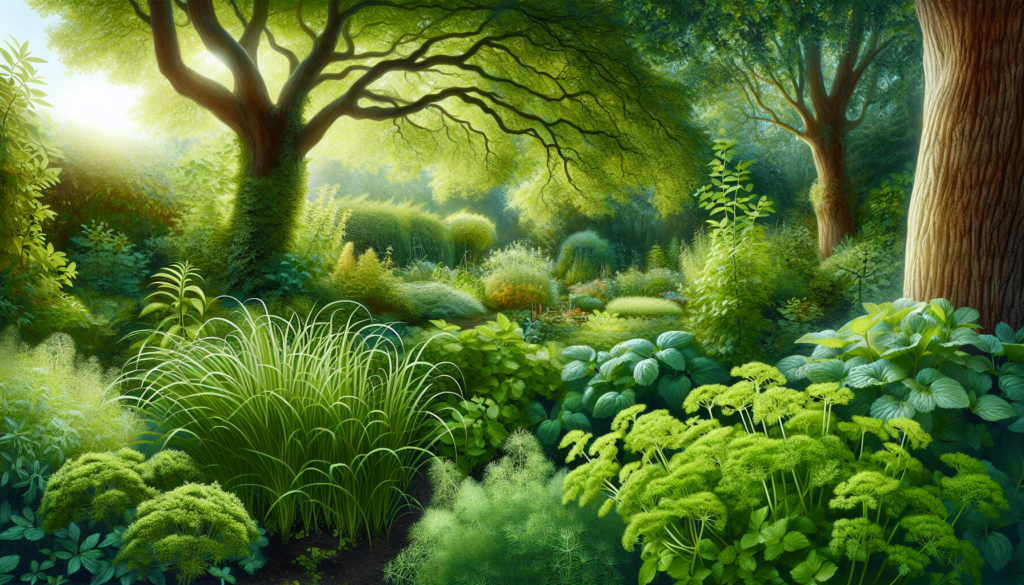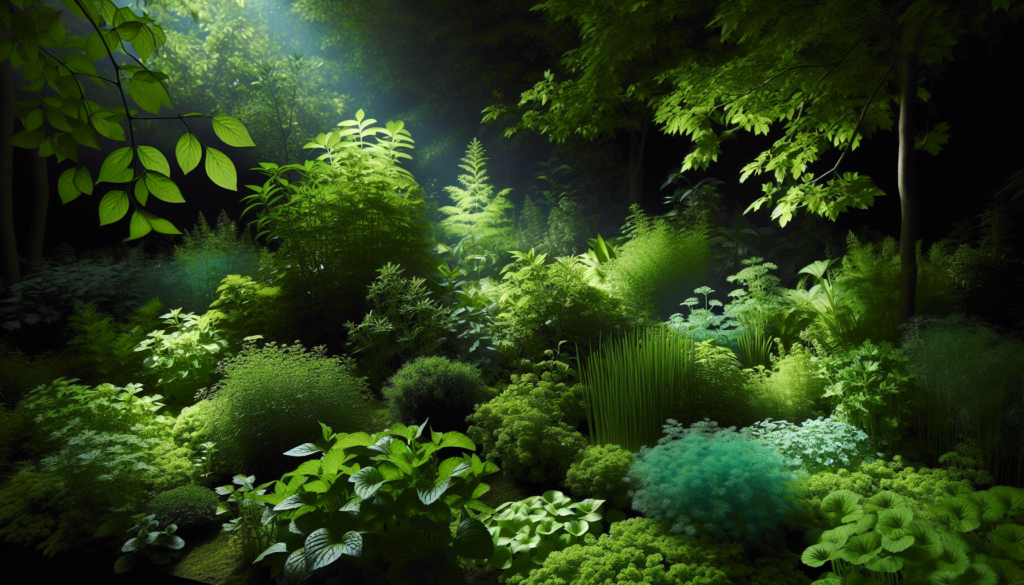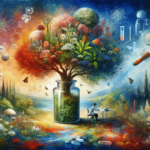If you enjoy cooking with fresh herbs but don’t have a sunny garden, don’t worry! There are plenty of herbs that thrive in the shade. From fragrant mint to versatile parsley, this article will guide you through the best herbs to grow in shady areas. Whether you have a small balcony or a shaded backyard, you’ll discover a variety of herbs that can add flavor and beauty to your dishes, even in the shadiest spots. So, grab your gardening gloves and let’s explore the world of shade-loving herbs! When it comes to growing herbs, many people believe that they need full sun in order to thrive. While it’s true that most herbs do prefer sunny conditions, there are actually many herbs that can grow beautifully in the shade. So if you have a shady spot in your garden that you’re not sure what to do with, consider planting some shade-loving herbs. In this article, we’ll explore a variety of herbs that are perfect for shady conditions, as well as provide some tips for growing them successfully.
Herbs that thrive in shade
Mint
Mint is a versatile herb that can thrive in both sunny and shady locations. In fact, a little bit of shade can help to prevent its leaves from scorching in hot weather. Mint is incredibly easy to grow and it spreads quickly, so be sure to plant it in a container or in a designated area of your garden to keep it from taking over. You can use fresh mint leaves in a variety of dishes, from salads to cocktails, and they also make a delicious addition to herbal teas.
Parsley
Parsley is another herb that can tolerate shade quite well. It has a subtle, fresh flavor that pairs well with a variety of dishes, making it a staple in many cuisines. Whether you’re adding it to a pasta dish or using it as a garnish for soups and stews, parsley is a versatile herb that can add both flavor and visual appeal to your meals. It’s also a great source of vitamins A, C, and K, as well as iron and antioxidants.
Chives
Chives are known for their mild onion flavor and are a popular addition to salads, eggs, and baked potatoes. These hardy perennials can tolerate partial shade and are quite easy to grow. Chives produce small, purple flowers that are not only beautiful but also edible. They can be used as a garnish or tossed into salads for an extra burst of color and flavor. If you’re looking for an herb that will thrive in a shady spot and add a touch of freshness to your dishes, chives are a great choice.
Herbs that tolerate shade
Lemon Balm
Lemon balm is a delightful herb with a bright lemony scent that can tolerate partial shade. It’s a member of the mint family and, like mint, it can spread quickly. Lemon balm leaves can be used to make herbal teas or infused into oils for use in skincare products. This herb is also believed to have calming properties, making it a great addition to your herb garden if you’re looking for something to help you relax.
Cilantro
Cilantro, also known as coriander, is another herb that can tolerate shade. While it prefers full sun, it will still grow reasonably well in shadier conditions. Cilantro leaves are commonly used in Mexican, Indian, and Southeast Asian cuisines. They have a bold, citrusy flavor that pairs well with spicy dishes. Cilantro is a great herb to have on hand if you enjoy making homemade salsas, curries, or guacamole.
Lavender
Lavender is a beautiful herb with fragrant purple flowers that can tolerate some shade. While it does prefer full sun, it can still bloom and grow reasonably well in shadier conditions. Lavender is commonly used in aromatherapy and is known for its calming and relaxing properties. The flowers can be used to make sachets, potpourri, or infused into oils for use in skincare products. So if you have a shady corner in your garden and want to add a touch of beauty and tranquility, consider planting some lavender.

Herbs that require partial shade
Basil
Basil is a popular herb that is typically associated with sunny Mediterranean climates. However, there are some varieties of basil that can tolerate partial shade. Sweet basil is one such variety that can grow reasonably well in shadier conditions. Basil adds a delightful, fresh flavor to dishes and is a key ingredient in classic Italian dishes like pesto and Caprese salad. If you’re growing basil in a shady spot, just be sure to provide it with a few hours of sunlight each day to keep it happy and healthy.
Dill
Dill is a versatile herb that can tolerate partial shade. It has delicate, feathery leaves and a unique flavor that pairs well with fish, potatoes, and pickles. Dill also produces small yellow flowers that attract beneficial insects like butterflies and bees. If you’re growing dill in a shady area, just make sure it still receives a few hours of sunlight each day. Dill is great for adding a pop of freshness to your dishes and can be easily grown from seeds.
Rosemary
Rosemary is a woody herb that is often associated with sunny Mediterranean climates. However, there are some varieties of rosemary that can tolerate partial shade. Rosemary has a strong, aromatic flavor that pairs well with roasted meats, potatoes, and bread. It can also be used to make infused oils or added to bath salts for a relaxing soak. If you’re growing rosemary in a shady spot, be sure to choose a variety that is more shade-tolerant, and provide it with a few hours of sunlight each day.
Herbs for shady containers
Thyme
Thyme is a low-growing herb that can tolerate shady conditions. It has small, fragrant leaves and a warm, earthy flavor that pairs well with a variety of dishes. Thyme is great for adding depth and complexity to sauces, soups, and stews. It can also be used to make infused oils or added to herb blends. If you’re growing thyme in a container, make sure it has good drainage and provide it with a few hours of sunlight each day to keep it healthy.
Oregano
Oregano is a popular herb in Mediterranean and Italian cuisines that can tolerate some shade. It has a strong, aromatic flavor that is commonly used in tomato-based dishes, pizza, and marinades. Oregano can be grown in containers and used fresh or dried for later use. If you’re growing oregano in a shady spot, just be sure to provide it with a few hours of sunlight each day to promote healthy growth.
Sage
Sage is a herb that can tolerate partial shade and is known for its distinct, savory flavor. It pairs well with poultry, pork, and sausage, and adds a unique flavor to stuffing and roasted vegetables. Sage is also commonly used in herbal teas and can be infused into oils for use in cooking or skincare products. If you’re growing sage in a container, make sure it has good drainage and provide it with a few hours of sunlight each day for optimal growth.

Herbs for shady borders
Tarragon
Tarragon is an herb that can tolerate some shade and is often used in French cuisine. It has a subtle, anise-like flavor that pairs well with chicken, fish, and eggs. Tarragon can be used fresh or dried, and its leaves can also be infused into vinegar for a flavorful dressing. If you’re growing tarragon in a shady border, just make sure it still receives a few hours of sunlight each day to promote healthy growth.
Borage
Borage is a versatile herb that can tolerate partial shade and has beautiful blue flowers. It has a cucumber-like flavor that is often used in salads and herbal teas. Borage flowers can also be used to garnish desserts or frozen into ice cubes for a touch of elegance. If you’re growing borage in a shady border, provide it with a few hours of sunlight each day to keep it thriving.
Fennel
Fennel is an herb that can grow reasonably well in shaded areas, although it prefers full sun. It has a distinct licorice-like flavor and is often used in both savory and sweet dishes. Fennel can be chopped and added to salads or roasted with vegetables for a flavorful side dish. The fronds can also be used as a garnish or infused into oils for cooking or skincare purposes. If you’re growing fennel in a shady border, be sure to provide it with a few hours of sunlight each day.
Herbs for shade-loving groundcovers
Creeping Thyme
Creeping thyme is a low-growing herb that can tolerate shade and is perfect for groundcover. It has small, aromatic leaves and produces tiny, pink flowers that attract bees and butterflies. Creeping thyme is often used in rock gardens or between stepping stones, as it can create a beautiful carpet-like effect. It’s also a great herb for adding a burst of freshness to grilled meats, roasted vegetables, or infused oils.
Sweet Woodruff
Sweet woodruff is a shade-loving herb that forms a spreading groundcover. It has delicate, star-shaped white flowers and leaves that have a sweet, vanilla-like scent when dried. Sweet woodruff is often used to make herbal teas or added to potpourri for a pleasant fragrance. If you’re looking for an herb that will add beauty to your shady garden while also providing a lovely aroma, sweet woodruff is an excellent choice.
Corsican Mint
Corsican mint is a small, creeping herb that can tolerate shade and is ideal for groundcover. It has tiny, round leaves that release a minty aroma when crushed. Corsican mint is often used to edge paths or in between pavers, as it can create an enchanting minty fragrance when stepped on. It can also be used in herbal teas or added to desserts for a refreshing twist. If you’re looking for a shade-loving groundcover that will release a delightful scent with every step, consider planting some Corsican mint.
Herbs for shady culinary use
Lemon Verbena
Lemon verbena is a herb that can tolerate some shade and is known for its bright, citrusy flavor. It’s often used as a substitute for lemon zest in recipes and adds a refreshing twist to a variety of dishes. Lemon verbena leaves can be used to make herbal teas or infused into syrups for cocktails and desserts. If you’re looking for an herb that will add a burst of lemony goodness to your culinary creations, lemon verbena is a fantastic choice.
Marjoram
Marjoram is a herb that can tolerate partial shade and is a close relative of oregano. It has a mild, sweet flavor that pairs well with a variety of dishes, from soups and stews to roasted meats and vegetables. Marjoram can be used fresh or dried, and its leaves can also be infused into oils for added flavor. If you’re growing marjoram in a shady spot, just make sure it still receives a few hours of sunlight each day to promote healthy growth.
Lovage
Lovage is a herb that can tolerate partial shade and has a strong, celery-like flavor. It’s often used as a substitute for celery in recipes and can add depth and complexity to soups, stews, and salads. Lovage leaves can also be infused into oils or used to make herbal teas. If you’re growing lovage in a shady area, provide it with a few hours of sunlight each day to ensure optimal growth.
Herbs for shade in herbal teas
Chamomile
Chamomile is a herb that can tolerate partial shade and is known for its calming properties. It has small, daisy-like flowers that can be dried and used to make herbal teas or infused into oils for skincare products. Chamomile tea is often used as a sleep aid or to promote relaxation and can be enjoyed hot or cold. If you’re looking for an herb that will help you unwind and find a moment of tranquility, chamomile is the perfect choice.
Lemon Balm
Lemon balm, as mentioned earlier, is a shade-tolerant herb that has a bright lemony scent. Its leaves can be used to make herbal teas that are refreshing and soothing. Lemon balm tea is often enjoyed for its calming properties and can be a great way to relax and unwind after a long day. If you’re growing lemon balm in a shady spot, you’ll have plenty of leaves to use for your herbal tea blends.
Spearmint
Spearmint is an herb that can tolerate partial shade and has a refreshing, minty flavor. Its leaves can be used to make herbal teas that are cooling and invigorating. Spearmint tea is often used to aid digestion or to simply enjoy as a refreshing beverage. If you’re looking for an herb to add a burst of minty goodness to your tea collection, spearmint is an excellent choice.
Herbs for medicinal purposes in shade
Valerian
Valerian is an herb that can tolerate partial shade and is known for its relaxing properties. It has tall, delicate flowers that produce a sweet, musky scent. Valerian roots can be dried and used to make herbal teas or powdered for use in capsules or tablets. Valerian is often used as a sleep aid or to promote relaxation and can be a great addition to your herb garden if you’re looking for natural remedies for stress and anxiety.
St. John’s Wort
St. John’s Wort is a herb that can tolerate some shade and is often used for its mood-enhancing properties. It has bright yellow flowers that are known to attract pollinators like bees and butterflies. St. John’s Wort leaves and flowers can be dried and used to make herbal teas or infused into oils for use in skincare products. If you’re considering growing St. John’s Wort in a shady spot, just make sure it still receives a few hours of sunlight each day for optimal growth.
Black Cohosh
Black Cohosh is a shade-tolerant herb that is commonly used for its medicinal properties in women’s health. It has tall, spiky flowers that produce a delightful fragrance. Black Cohosh roots can be dried and used to make herbal teas, tinctures, or capsules. This herb is often used to help alleviate symptoms of menopause such as hot flashes and mood swings. If you’re growing Black Cohosh in a shady spot, you’ll have access to its beneficial properties for a variety of health issues.
Growing tips for herbs in shade
Choosing the right location
When growing herbs in the shade, it’s important to choose the right location. Look for areas in your garden that receive at least a few hours of sunlight each day, whether it’s in the morning or afternoon. While herbs can tolerate shade, they still need some sunlight to grow and thrive.
Providing indirect sunlight
If your chosen spot doesn’t receive direct sunlight, you can still provide your herbs with indirect sunlight. This can be achieved by placing them near reflective surfaces, such as light-colored walls or fences. Reflected sunlight can help supplement the natural light your herbs receive and promote healthy growth.
Amending the soil
When planting herbs in shady areas, it’s important to prepare the soil properly. Most herbs prefer well-drained soil, so be sure to amend your soil with organic matter, such as compost or aged manure, to improve its texture and fertility. This will ensure that your herbs have the nutrients they need to grow and thrive in shady conditions.
In conclusion, while many herbs prefer sunny conditions, there are plenty of shade-loving herbs that can thrive in shady areas of your garden. Whether you’re looking to add some freshness to your culinary creations, create a calming herb garden, or grow medicinal herbs, there are options available for every need. By choosing the right herbs, providing them with some sunlight, and amending the soil, you can successfully grow a variety of herbs in the shade. So don’t let a lack of sunlight deter you from enjoying the many benefits that herbs have to offer. Get creative with your garden and explore the wonderful world of shade-loving herbs.





